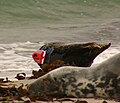Animal identification
Appearance

Animal identification using a means of marking is a process done to identify and track specific animals. It is done for a variety of reasons including verification of ownership, biosecurity control, and tracking for research or agricultural purposes.
History
Individual identification of animals by means of body markings has been practiced for over 3,800 years, as stated in Code of Hammurabi.[1] The first official identification systems are documented as far as the 18th century. In Uruguay for instance maintained at that time a register of hot brands.[2]
Methods
Birds
- Leg rings
- Wing tags
- Microchip implants (parrots)
- Telemetry (falconry birds)
Sheep
- Freeze branding
- Branding (hot-iron)
- Collar
- Earmarking
- Ear tags (non-electronic)
- Ear tags (electronic)
- Semi-permanent paint
Pigs
- Collars (electronic and non-electronic)
- Earmarking
- Ear tags (non-electronic)
- Ear tags (electronic)
- Semi-permanent paint
- Tattoo
Horses
- Collars (non-electronic)
- Branding (hot-iron)
- Branding (freeze)
- Microchip implants
- Lip tattoo
Cattle
- Anklets
- Branding (freeze)
- Branding (hot-iron)
- Collars (electronic and non-electronic)
- Earmarking
- Ear tags (non-electronic)
- Ear tags (electronic)
- Rumen bolus (electronic)
- Cowbell
Dogs
- Collar
- Microchip implants
- Tattoo
Laboratory mice
- Earmarking (notching or punching)
- Ear tags (nickel, copper or scannable 2D barcode tags)
- Microchip implants
- Hair dye
- Toe clipping[note 1]
- Manual tattoos (tail, foot pad or ears)
- Automated tail tattoos[3]
Fish
- Microchip implants
- Fin clipping
- Coded wire tag
- Passive integrated transponder
- Acoustic tag
- Visible implant elastomer (VIE)
Marine mammals
- Transponders
- Adhesive tags
Amphibians
- Microchip implants
- Toe clippings
- Passive integrated transponder
- Visible implant elastomer (VIE)[4]
Invertebrates
- Adhesive tags
- Semi-permanent paint
National animal identification schemes
- British Cattle Movement Service in Britain
- National Animal Identification and Tracing in New Zealand
- National Animal Identification System in the United States
- National Livestock Identification System in Australia
Footnotes
- ^ 'Toe clipping' in mice involves the full or partial amputation of one or more digits as a means of permanent identification.
Gallery
-
Great frigatebird with a wing tag
-
Bird ring
-
Sheep with an earmark
-
Pig with earmark
-
Horse with a brand
-
Santa Gertudis cattle with electronic and non-electronic ear tags
-
Calf with a non-electronic ear tag, numbered collar and transponder (blue device)
-
Bear with an ear tag and transponder
-
Tattoo inside a Greyhound's ear
-
Dog collar with dog license and other dog tags
-
A microchip implant and applicator
-
A laboratory mouse with an ear tag
-
Fish with a transponder
-
Harbour seal with a transponder
-
Common seal with an adhesive tag
-
Africanised honeybee with a paint spot
-
Sheep with painted number
-
Monarch butterfly tagged with a sticker
-
Mussels being tagged
References
- ^ Blancou, J (2001). "A history of the traceability of animals and animal products". Revue scientifique et technique (International Office of Epizootics). 20 (2): 413–25. PMID 11548516.
- ^ http://www.allflex-group.com/front-offices/anglais/119-the_history_of_livestock_identification.aspx?idparentnode=120
- ^ Bell, J. "Labstamp system" (PDF). Archived from the original (PDF) on February 26, 2015. Retrieved February 26, 2015.
- ^ Fouilloux, Chloe; Garcia-Costoya, Guillermo; Rojas, Bibiana. "Visible Implant Elastomer (VIE) Success in Early Larval Stages of a Tropical Amphibian Species". PeerJ. doi:10.7717/peerj.9630.
{{cite journal}}: CS1 maint: unflagged free DOI (link)
Wikimedia Commons has media related to Animal identification.


















